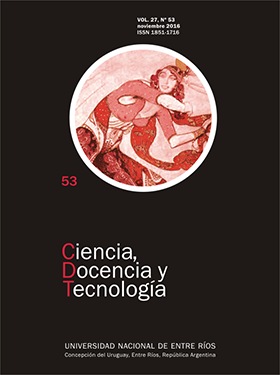Estrategias para fortalecer capacidades dinámicas de innovación: una visión desde las micro y pequeñas empresas
Palabras clave:
microempresa, pequeña empresa, capacidades dinámicas, innovaciónResumen
Las micro y pequeñas empresas por sus características particulares en recursos y procesos de operación, presentan mayores dificultades para enfrentar la innovación como un desafío estratégico. Este artículo busca identificar algunas estrategias para fortalecer capacidades para la innovación en dichas empresas. Con este propósito se realizó una selección y revisión de documentos académicos en torno a las capacidades para la innovación, en los cuales se muestran la necesidad de trabajar en tres capacidades: exploración, explotación y mantenimiento o reconfiguración. La literatura académica tiende a mostrar estrategias de fortalecimiento orientadas a empresas que cuentan con recursos para realizar innovación; sin embargo, las micro y pequeñas empresas requieren igualmente de acciones ajustadas a sus limitaciones con el fin de que puedan crecer y mantenerse en el mercado.
Descargas
Citas
ABESON, F.; TAKU, M. (2009). Knowledge source and small business competitiveness. Competitiveness Review, 12 (2): 88-96.
ACOSTA, J.; FISCHER, A. (2013). Condiciones de la gestión del conocimiento, capacidad de innovación y resultados empresariales. Un modelo explicativo. Pensamiento y Gestión, 35: 25-63.
BARNEY, J. (1991). Firm resources and sustained competitive advantages. Journal of Management, 17(1): 99-120.
BELTRÁN, A.; PULIDO, B. (2012). Innovación: estrategia que contribuye a asegurar crecimiento y desarrollo en micro, pequeñas y medianas empresas en Colombia. Sotavento M.B.A, 19: 104-113.
BERGMAN, J.; JANTUNEN, A.; y SAKSA, J.-M. (2001). Managing knowledge creation and sharing – scenarios and dynamic capabilities in inter-industrial knowledge networks. Journal of Knowledge Management, 8(6); 63-76.
BRAVO, E.; SIMO, P. (2010). Determinantes de la capacidad de innovación y su relación con el desempeño: estudio empírico de empresas catalanas. IV International Conference on Industrial Engineering and Industrial Management - XIV Congreso de Ingeniería de Organización: 783-789. Donostia - San Sebastian.
BREZNIK, LD.; HISRICH, R. (2014). Dynamic capabilities vs. innovation capability: are they related?. Journal of Small Business and Enterprise Development, 21(3), 368-384. http://dx.doi.org/10.1108/JSBED-02-2014-0018
CAPUTO, A.; CUCCHIELLA, F.; FRATOCCHI, L.; PELAGAGGE, P., y
SCACCHIA, F. (2002). A methodological framework for innovation transfer to SMEs. Industrial Management & Data Systems, 10(5): 271-283.
ČIUTIENĖ, R.; THATTAKATH, E. (2014). Influence of Dynamic Capabilities in Creating Disruptive Innovation. Economics and Business, 26: 15-21.
CLAUSS, T. (2012). The Influence of the Type of Relationship on the Generation of Innovations in Buyer–Supplier Collaborations. Creativity and Innovation Management, 21(4): 388-411.
DAQUI, X. (2013). Research on Improving the Technological Innovation Capability of SMEs by University-Industry Collaboration. Journal of Engineering Science y Technology Review, 6(2): 100-104.
DESCHAMPS, J. (2005). Different leadership skills for different innovation strategies. Strategy & Leadership, 33 (5): 31-38.
DINERO. (2015). ¿Por qué fracasan las pymes en Colombia? Dinero. Disponible en: <http://www.dinero.com/economia/articulo/pymes-colombia/212958> [2 de septiembre de 2015]
EISENHARDT, K.; MARTIN, J. (2000). Dynamic Capabilities: what are they? Strategic Management Journal: 1105-1121.
ELLONEN, H.-K.; JANTUNEN, A.; KUIVALAINEN, O. (2011). The role of dynamic capabilities in developing innovation-related capabilities. International Journal of Innovation Management, 15 (3): 459-478.
GARCÍA, F.; PELECHANO, E.; NAVAS, J. (2007). Las fuentes de conocimiento y la estrategia tecnológica: una cuestión de ajuste. Empresa global y mercados locales: XXI Congreso Anual AEDEM, 6,7 y 8 de junio de 2007: 67-82. Madrid: Universidad Rey Juan Carlos.
GARZÓN, M.A. (2015). Modelo de capacidades dinámicas. Revista Dimensión Empresarial, 13(1), 111-131.
GIESEN, E.; BERMAN, S.; BELL, R.; BLITZ, A. (2007). Three ways to successfully innovate your business model. Strategy y Leadership, 35(6): 27-33.
GOLDENBERG, J.; HOROWITZ, R.; LEVAV, A.; MAZURSKY, D. (2003). Finding Your Innovation Sweet Spot. Harvard Business Review. Disponible en:< https://hbr.org/2003/03/finding-your-innovation-sweet-spot > [15 de julio de 2015]
GONZÁLEZ, J.; GARCÍA, L.; LUCERO, C.; y ROMERO, N. (2014). Estrategia y cultura de innovación, gestión de los recursos y generación de ideas: prácticas para gestionar la innovación en empresas. Pensamiento y gestión, 36: 109-135.
GRIMALDI, M.; QUINTO, I.; RIPPA, P. (2013). Enabling Open Innovation in Small and Medium Enterprises: A Dynamic Capabilities Approach. Knowledge and Process Management, 20(4): 199-210.
HELFAT, C.; FINKELSTEIN, S.; MITCHELL, W.; PETERAF, M., SINGH, H.;
TEECE, D.; WINTER, S. (2007). Dynamic Capabilities: Understanding Strategic Change in Organizations. Malden: Blackwell.
HIDALGO, A.; ALBORS, J. (2008). Innovation Management Techniques and Tools: a review from Theory and Practice. R&D Management, 38(2): 113-127.
HUANG, J.; FASNACHT, D.; STARKEY, K.; TEMPEST, S. (2006). The development of architectural ambidexterity: information technology in an age of hyper competition. Academy of Management Best Conference Paper.
IGARTUA, J.; ALBORS, J.; HERVAS-OLIVER, J. (2010). How Innovation Management Techniques Support an Open Innovation Strategy. Research Technology Management: Industrial Research Institute, 2: 41-52.
ILEVBARE, I.; PROBERT, D.; PHAAL, R. (2013). A review of TRIZ, and its benefits and challenges in practice. Technovation: 30-37.
IMAGINATIK. (14 de julio de 2015). Making innovation "real": Navigating the innovation maturity roadmap. Imaginatik. Disponible en:< http://imaginatik.com/resources/paper-making-innovation-real-navigating-innovation-maturity-roadmap > [10 de agosto de 2015]
JIMÉNEZ, J., y SANZ, V. (2004). Determinantes del éxito de la innovación. Revista de Empresa, 7: 24-38.
KOHLBACHER, M. (2013). The impact of Dynamic Capabilities through continuous improvement o innovation: the role of business process orientation. Knowledge and Process Management: 71-76.
LATORRE, J., SALINAS, C., y HERNÁNDEZ, P. (2011). Sistema de gestión de ideas innovadoras y oportunidades de negocio a partir de la Vigilancia Tecnológica. AIMPLAS Instituto Tecnológico del Plástico, 1-9. Obtenido de Sistema de gestión de ideas innovadoras y oportunidades de negocio a partir de la Vigilancia Tecnológica.
LAVIE, D. (2006). Capability reconfiguration: an analysis of incumbent responses to technological change. Academy of management Review, 31(1): 153-174.
LAWSON, B., y SAMSON, D. (2001). Developing innovation capability in organizations: a dynamic capabilities approach. International Journal of Innovation Management, 5 (3): 377-400.
LIEDTKA, J. (2011). Learning to use design thinking tools for successful innovation. Strategy & Leadership, 39(5): 13-19.
LÓPEZ, L., TRICÁS, J., y TOLEDANO, R. (2013). Principales prácticas de recursos humanos de las PyMEs industriales exitosas. Universidad y Empresa, 23: 19-43.
MAZZEI, M., FLYNN, B., y HAYNIE, J. (2015). Moving beyond initial success: promoting innovation in small business through high-performance work practices. Business Horizons.
MILLER, K.D.; MORRIS, L. (1999). 4th Generation R&D- Managing Knowledge, Technology, and Innovation. New York: John Wiley.
MINCIT. (2012). Definición Tamaño Empresarial Micro, Pequeña, Mediana o Grande. Portal Mipymes - Ministerio de Comercio, Industria y Turismo. Disponible en: <http://www.mipymes.gov.co/publicaciones.php?id=2761> [19 de septiembre de 2015]
MORALES, M.; ORTIZ, C.; ARIAS, M. (2012). Factores determinantes de los procesos de innovación: una mirada a la situación en Latinoamérica. Rev. esc.adm.neg., 72: 148-163.
MULLER, A.; HUTCHINS, N.; CARDOSO, M. (2012). Applying open innovation where your company needs it most. Strategy y Leadership, 40(2): 35-42.
NAGJI, B.; TUFF, G. (2012). Managing Your Innovation Portfolio. Harvard Business Review, 5. Disponible en: <https://hbr.org/2012/05/managing-your-innovation-portfolio#> [17 de septiembre de 2015]
NOFAL, N. (2007). La gestión del conocimiento como fuente de innovación. Revista Escuela de Administración de Negocios, 61: 77-87.
NONAKA, I.; TAKEUCHI, H. (1995). The Knowledge Creating Company. New York: Oxford University Press
OCDE; EUROSTAT. (2006). Manual de Oslo: guía para la recogida e interpretación de datos sobre innovación. París: Tercera edición. OCDE y EUROSTAT.
OSTERWALDER, A.; PIGNEUR, Y. (2010). Business Model Generation: A Handbook for Visionaries, Game Changers, and Challengers. New Jersey: Wiley.
OTHMAN, M.; AMARAA, N.; LANDRYA, R. (2012). SME's degree of openness: the case of manufacturing industries. Journal of Technology Management y Innovation, 7(1): 88-210.
PETERAF, M.A. (1993). The cornerstone of competitive advantage: a resource-based view. Strategic Management Journal, 14: 179-91.
PINHO, J. (2011). Social capital and dynamic capabilities in international performance of SMEs. Journal of Strategy and Management, 4(4): 404-421.
PORTER, M. (1980). Estrategia Competitiva, Nueva York: The Free Press
SCHIELE, H. (2012). Accessing supplier innovation by being their preferred customer. Research Technology Management: 44-50.
STAMM, B. (2009). Leadership for innovation: what you can do to create a culture conducive to innovation. Strategic Direction, 25 (6): 13-15.
STERN, Y.; LEVAV, A. (2005). The DNA of Ideas: systematically creating coincidental product evolution. BIO-IT World: 56-57.
TEECE, D. (2007). Explicating dynamic capabilities: the nature and micro foundations of (sustainable) enterprise performance. Strategic Management Journal, 28: 1319-1350.
TEECE, D. (2009). Dynamic capabilities and strategic management: Organizing for innovation and growth. Nueva York: Oxford University Press.
TERWIESCH, C.; ULRICH, K. (2008). Managing the opportunity portfolio. R&D/Business Strategy: 27-38.
WANG, C.; AHMED, P. (2007). Dynamic capabilities: a review and research agenda. International Journal of Management Reviews, 9(1), 31-51.
WANG, Y.; XINPING, S. (2011). Thrive, not just survive: enhance dynamic capabilities of SMEs through IS competence. Journal of Systems and Information Technology, 13(2): 200-222.
WERNERFELT, B. (1984). A resource-based view of the firm. Strategic Management Journal, 5(2): 171-80.
WU, Q.; HE, Q.; DUAN, Y.; O'REGAN, N. (2012). Implementing Dynamic Capabilities for Corporate Strategic Change toward Sustainability. Strategic Change, 21: 231-247.
YEW, K.; ASPINWALL, E. (2004). Characterizing knowledge management in the small business environment. Journal of Knowledge Management: 44-62.
ZOLLO, M.; WINTER, S. (2002). Deliberate Learning and the Evolution of Dynamic Capabilities. Organization Science, 13(3): 339-351.
Descargas
Publicado
Cómo citar
Número
Sección
Licencia
Los autores conservan los derechos de autor y garantizan a la revista el derecho de ser la primera publicación del trabajo, al igual que licenciarlo bajo una Creative Commons Attribution License que permite a otros compartir el trabajo con un reconocimiento de la autoría del trabajo y la publicación inicial en esta revista. Todo el contenido es publicado bajo licencia internacional Creative Commons 4.0: Atribución-No Comercial-Compartir Igual.






